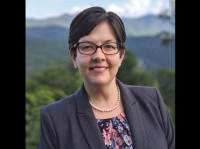Town has begun thinning white pine
 I believe it was in 2010 when the Town of Waynesville signed off on a plan to thin the stands of white pine in the Waynesville Watershed. Today (11/25), Cecil Brooks began doing just that. Brooks said that, weather permitting, he would probably be hauling the first load out tomorrow. The problem has been that there was no viable market for white pine.
I believe it was in 2010 when the Town of Waynesville signed off on a plan to thin the stands of white pine in the Waynesville Watershed. Today (11/25), Cecil Brooks began doing just that. Brooks said that, weather permitting, he would probably be hauling the first load out tomorrow. The problem has been that there was no viable market for white pine.
According to Rob Lamb, executive director of Forest Stewards (the organization that helped create the town’s Watershed Management Plan and is responsible for its implementation), there were no responses to sealed bids that went out about a year ago.
“We then began talking with contractors we knew,” Lamb said, “and Cecil decided to take the project on.”
Brooks has worked with Forest Stewards before and has also worked in a watershed environment. “We’re happy Cecil is doing the work. We’ve worked with him before and he knows we [Forest Stewards] are pretty demanding,” said Lamb.
There are about 51 acres across the watershed that will be treated. Lamb said that 42 of those acres would be subject to thinning and that the other nine would be a hardwood regeneration area.
Related Items
“The work we are doing is restoration work,” he said. “We are transitioning the forest from a non-native white pine ecosystem to a more natural, native hardwood forest.”
Dr. Pete Bates, natural resources professor at Western Carolina University and president of the Forest Stewards board of directors, has been involved with the town’s watershed easements since 2004 (or earlier) when the town began acquiring the property. Part of the watershed, the acres purchased with funds from the EPA and North Carolina’s Clean Water Management Trust Fund, are in a “forever wild” easement and will not be actively managed.
Most of the watershed, though, is in a “working forest” easement co-held by the Southern Appalachian Highlands Conservancy (SAHC) and the Conservation Trust for North Carolina (CTNC). Bates said that the white pine treatment is a manifestation of the philosophy of the watershed management plan which states, “The best forest management strategy for protecting water resources on the property is to create and maintain a diverse forest of healthy, naturally occurring plant communities.”
Rusty Painter, CTNC’s land protection director, said his organization had the utmost confidence in Forest Stewards and believed the work in Waynesville’s watershed could be a teaching moment. “It can demonstrate that forestry, done properly, is wholly compatible with forest health.” Painter also noted that CTNC would have boots on the ground in the watershed to monitor the project.
Carl Silverstein, executive director at SAHC, echoed Painter’s praise of Forest Stewards.
He said that knowing Forest Stewards and Bates would be creating the management plan helped ensure SAHC’s participation in the easement.
Hanni Muerdter, SAHC’s stewardship and conservation planning director, said that she had recently visited the site. “Our language is very specific,” Muerdter, said, “the harvest must be overseen by a registered forester — and that’s where Forest Stewards comes in.” Muerdter said she was quite comfortable with Lamb’s and Forest Stewards’ abilities and felt confident that all best management practices would be exceeded.
Bates, a perennial co-leader of Waynesville’s annual watershed hikes, noted that the thinning might not be the prettiest sight next spring. “It’ll basically look like a thinned stand of white pine with slash strewn about on the forest floor. Those who don’t like to see any kind of logging may not like what they see, but by the end of the summer, by next fall there will be herbaceous growth where light is getting through to the forest floor and probably some poplar and other hardwood saplings.”
I am also one of the leaders on the annual watershed hikes, and I generally lead my group through a portion of the white pine stand. It’s usually near the end of the hike and people who are strolling along and chatting with one another — I don’t say anything — just walk about 100 feet or so into the stand and stop. Then I ask if the group notices anything different. Usual responses are, “There’s nothing here,” or “It’s so quiet.” And we get to talk for a moment about the differences between the forest we just left with its myriad species of trees, shrubs, wildflowers and different birds and this unnatural, quiet and empty monoculture of white pine.
I look forward to seeing the difference next fall.









